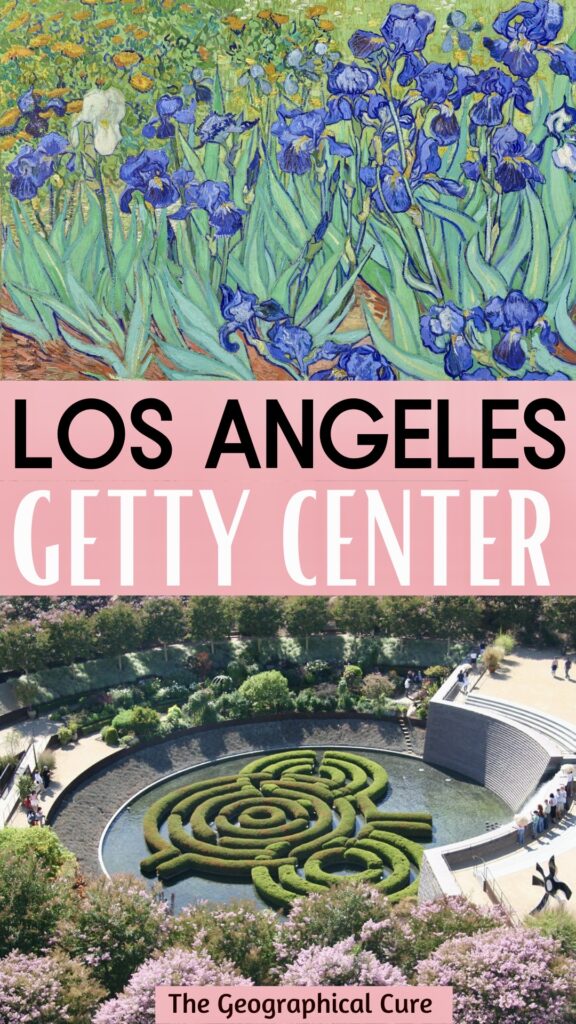Planning a visit to the Getty Center in Los Angeles? This is the ultimate guide to visiting the Getty, which is one of the best art museums in the United States. I identify 20 must see masterpieces and give you must know tips for visiting.
The Getty Center showcases the best art that money can buy. LA’s hilltop acropolis houses the magnificent collection of billionaire oil magnate J. Paul Getty.
Getty wasn’t just wealthy. He was a true connoisseur, a lifelong history buff and art lover. He built a fantastic art collection rich in Greco-Roman works and old master paintings.
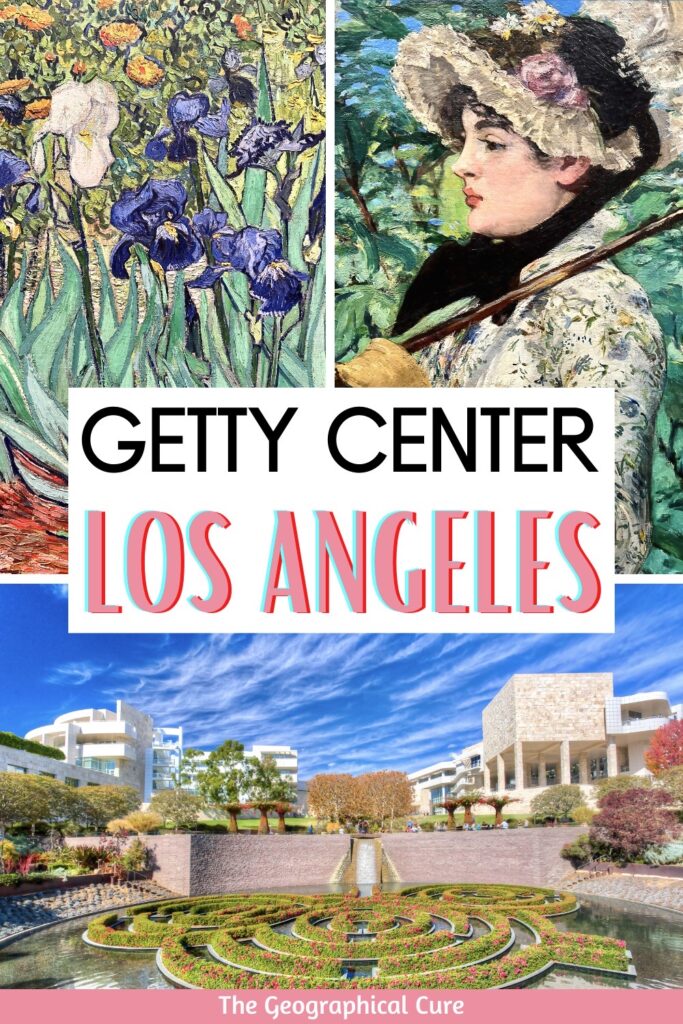
Today, 2 million tourists a year visit the Getty Center, housed in a fabulous Richard Meier designed museum space. They come for the fabulous art, gorgeous city views, water features, and lush gardens.
Overview Of The Getty Center
Who Was J. Paul Getty?
J. Paul Getty was an oil tycoon and art enthusiast. He came from money and power. With a loan from his father, he invested in oil wells in the Middle East and became “the richest man in the history of the world.”
But Getty didn’t just have oil fever. Getty started seriously collecting art in the 1930s and was a passionate and lifelong collector.
Trips to Italy left him with a taste for bronze and marble sculptures from ancient Greece and Rome. He then developed a taste for old masters from the Renaissance and Baroque periods.
Getty believed that art should be displayed in a place of “equal quality.” In 1954, he added a museum wing to his 64 acre Malibu ranch.
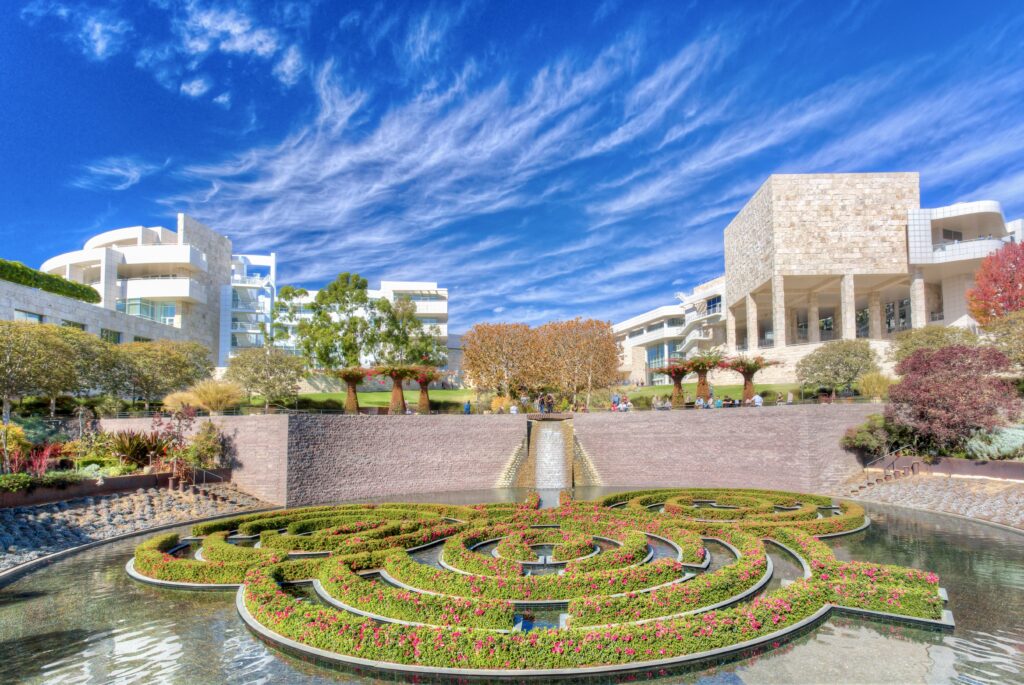
But that wasn’t enough space either. So, in 1974, Getty built a replica of an Italian villa from Herculaneum, known today as the Getty Villa, and moved his collection there.
Getty never saw his audacious villa-museum. In 1951, he moved to England for good. Getty didn’t return to the US because of a fear of flying. But he approved every Getty acquisition until his death in 1976.
Overview & History Of The Getty Center
Creation Of The Getty Center
In his will, Getty left the bulk of his fortune ($700 million) to the J. Paul Getty Trust. Overnight, the Getty became the most richly endowed museum in the world.
In 1984, the trust decided they needed more room to house the ever-burgeoning collection. It commissioned Richard Meier to build a billion dollar campus.
In 1996, the bulk of the museum’s collection was relocated there and the museum opened in 1997. The pieces from antiquity remained at the Getty Villa.
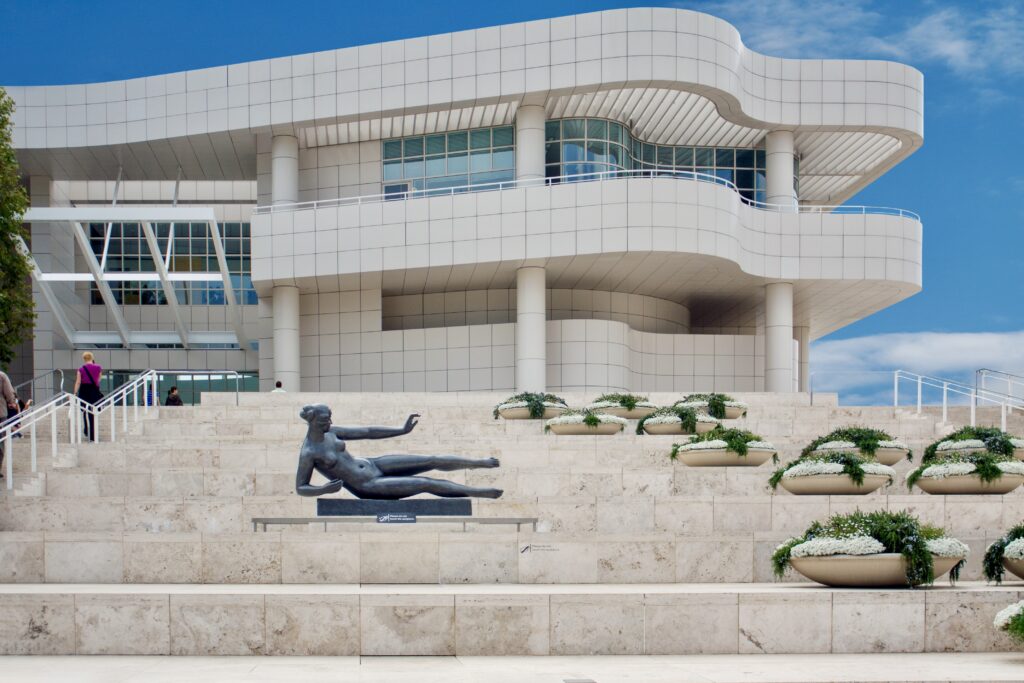
Perched on a hilltop, the Getty Center is a beguiling modern day temple made of rough surfaced travertine stone, aluminum panels, and glass. It’s a place where undulating lines follow the natural terrain of the Santa Monica Mountains.
Terraces offer beautiful views of the city and ocean. In the late afternoon, the buildings looks almost golden.
The Getty Center, moreover, is more than a museum. It’s an art institution and urban laboratory. It houses research and administrative centers, conservations programs, and a grant institution. The original collection that Getty amassed has also been expanded to include photographs, drawings, and sculptures.
Layout Of The Getty Center
You enter the museum up a flight of stairs to reach the large Museum Entrance Hall. There you can pick up a map of the museum and other brochures. You can also sign up for one of the Getty’s free tours.
The permanent collection is housed in four pavilions — North Pavilion, East Pavilion, South Pavilion, and West Pavilion. The galleries are minimalist, with skylights and coved ceilings that show off the art with natural light instead of electric light.
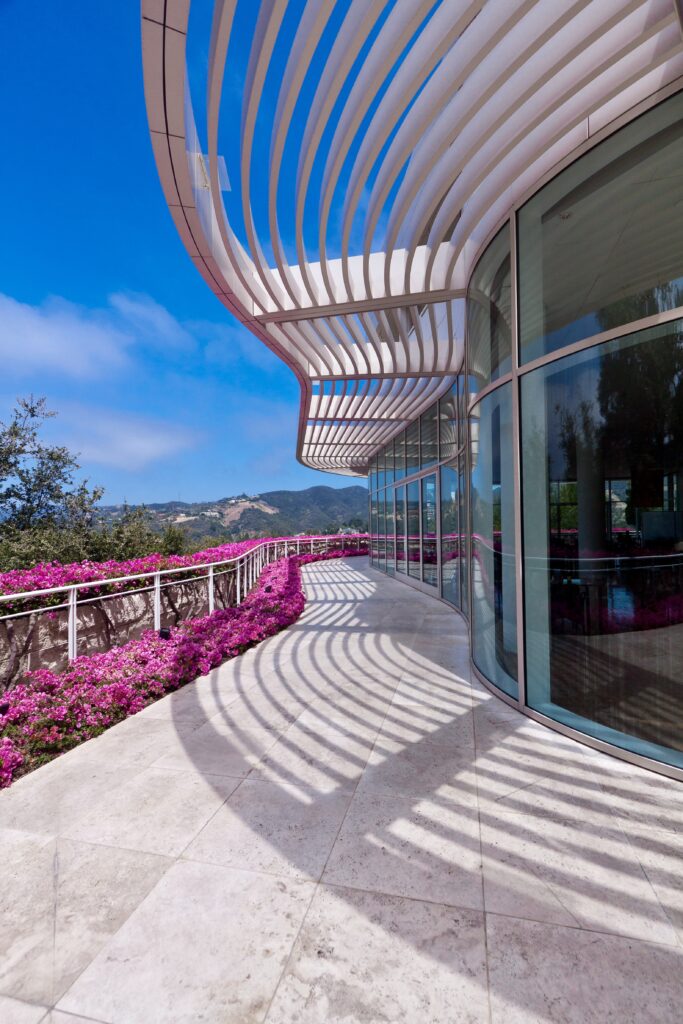
The Getty’s most famous painting, Van Gogh’s (Irises), is in the West Pavilion. Adjacent to that pavilion is the Fran and Ray Stark Sculpture Terrace.
In the center of the complex is a museum courtyard and Exhibition Pavilion. When I was there, the Getty had mounted a fascinating Cy Twombly exhibit exploring the artist’s fascination with Greco-Roman art and poetry.
The Central Garden and Lower Terrace Sculpture Garden are to the Far East of the complex.
The separate pavilions and garden complexes allow you to catch your breath and relax in indoor/outdoor spaces as you proceed from pavilion to pavilion. It makes for a better museum experience than endlessly walking through the typical white or gray corridors.
You can check out this online map to help plan your visit.
Guide To The Getty Center: What To See
The Getty collection covers the period from the Middle Age to the early 20th century. There is no modern art save for the outdoor sculptures.
Here are the top 20 masterpieces and things to see on a visit to the Getty.
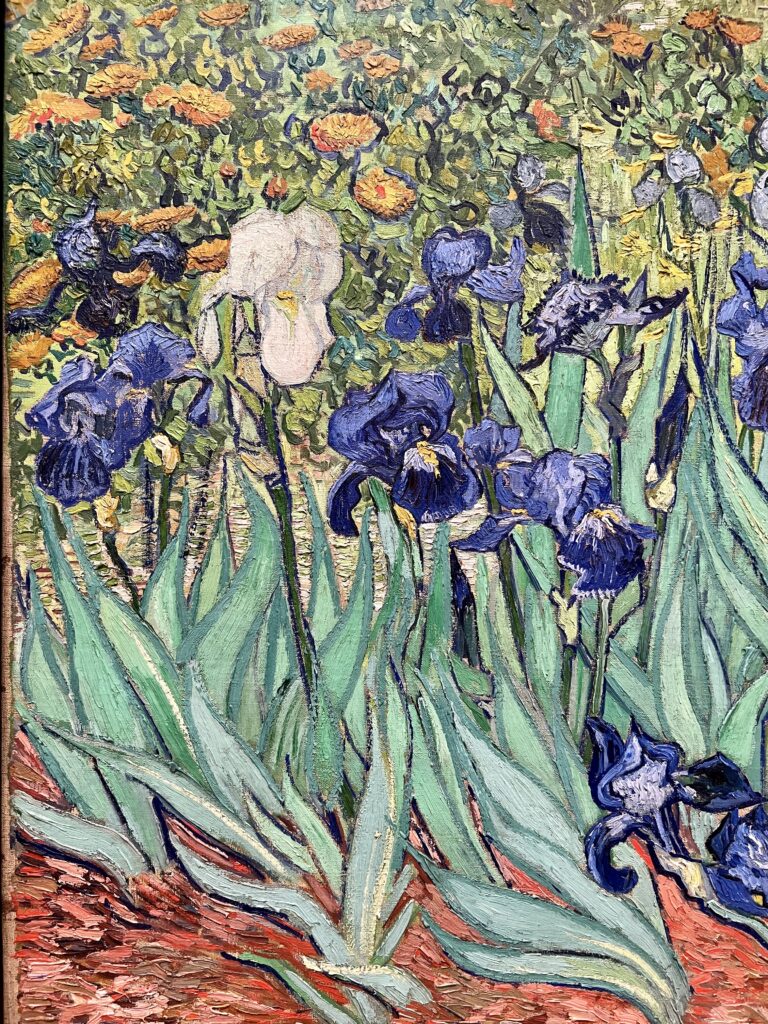
1. Van Gogh, Irises
The absolute star of the Getty Center is Vincent Van Gogh’s Irises. In fact, it’s so sought after that the museum employees may point you right to the West pavilion where it’s housed.
Van Gogh was a Dutch Post-Impressionism artist now considered one of the greatest and most influential painters in art history.
Van Gogh’s work is notable for its swirling line, emotional honesty, and bold vivid color. His radical landscapes were like nothing anyone had painted before.
Irises has Van Gogh’s trademark exuberance. It’s a swirling mass of green and blue flowers with powerful brush strokes. You can almost feel the paintings strong colors and rhythmic vitality.
Van Gogh painted the scene after slicing off his own ear and landing in an insane asylum. The irises were in the asylum garden, and provided a therapeutic outlet for the tortured artist.
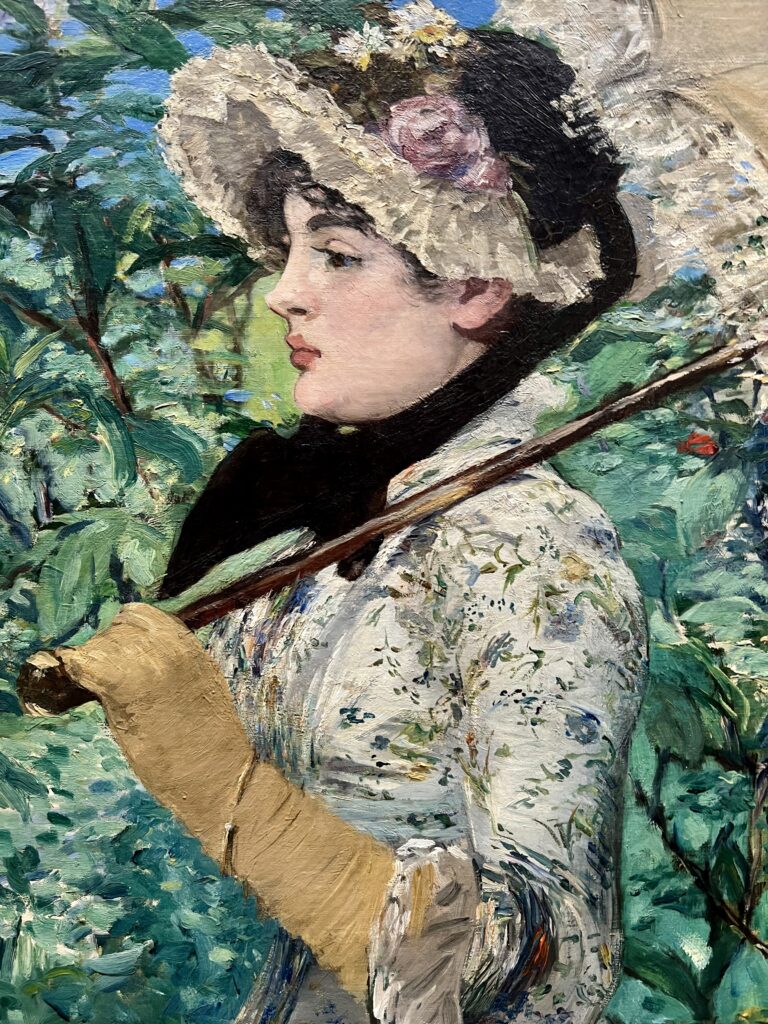
2. Edouard Manet, Spring
Manet is known as the “Father of Impressionism,” though he really preceded and overlapped with the movement.
Manet had a huge impact on the development of modernism. He led a bohemian life and scandalized the official Salon with his utter disregard for academic conventions and his strikingly modern images of urban life.
This late Manet portrait depicts a young actress as the embodiment of spring. The actress wears a floral ensemble and is set against a lush background of rhododendrons.
The painting is one of Manet’s most vibrant works. His color palette was typically darker. It was exhibited at the 1882 Paris Salon to rave reviews.
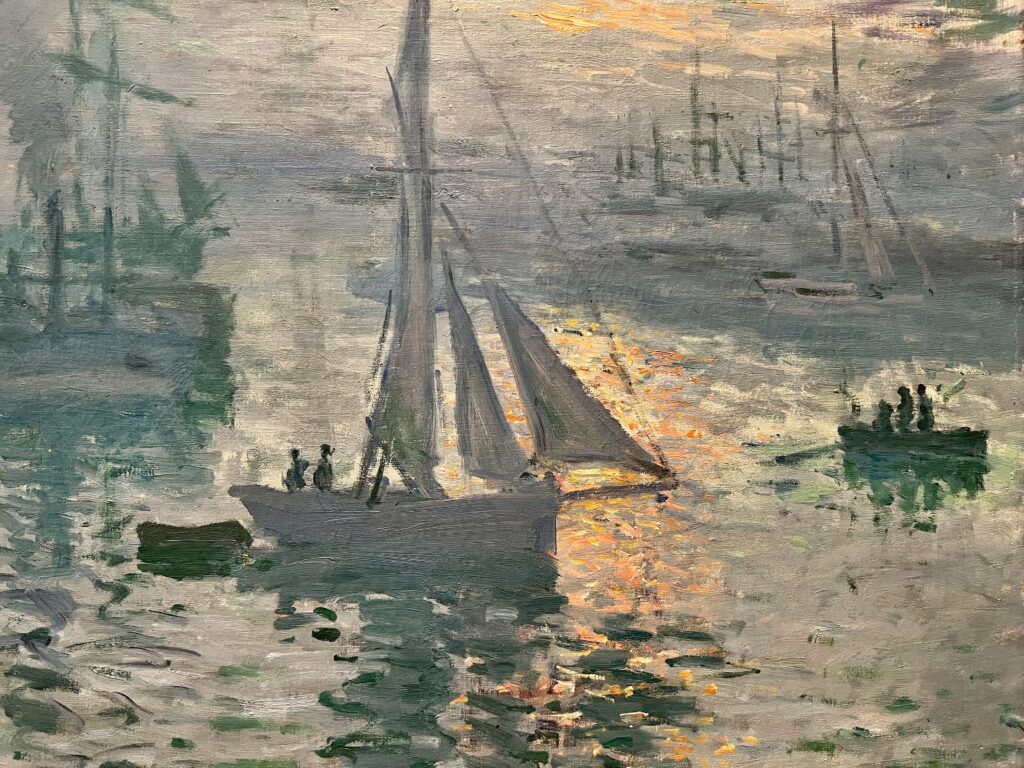
3. Claude Monet Works
The Getty has a trio of significant paintings by the ever-popular Impressionist artist Claude Monet.
Sunrise is a painting that kicked off the Impressionism movement. Along with its companion piece Impression Sunrise at Paris’ Musee Marmottan Monet, it exemplifies Monet’s “plein air” (outdoor) approach to painting and his signature informal and spontaneous brushstrokes.
The painting shocked critics. They denigrated it as an unskilled “impression,” rather than a polished art work. That term gave rise to the movement’s name.
Wheatstacks was Monet’s first series and the first in which he concentrated on a single subject. In each canvas, the light is different depending on the time of day he painted. The painting reveals Monet’s signature ability to capture form and light with small dabs of paint.
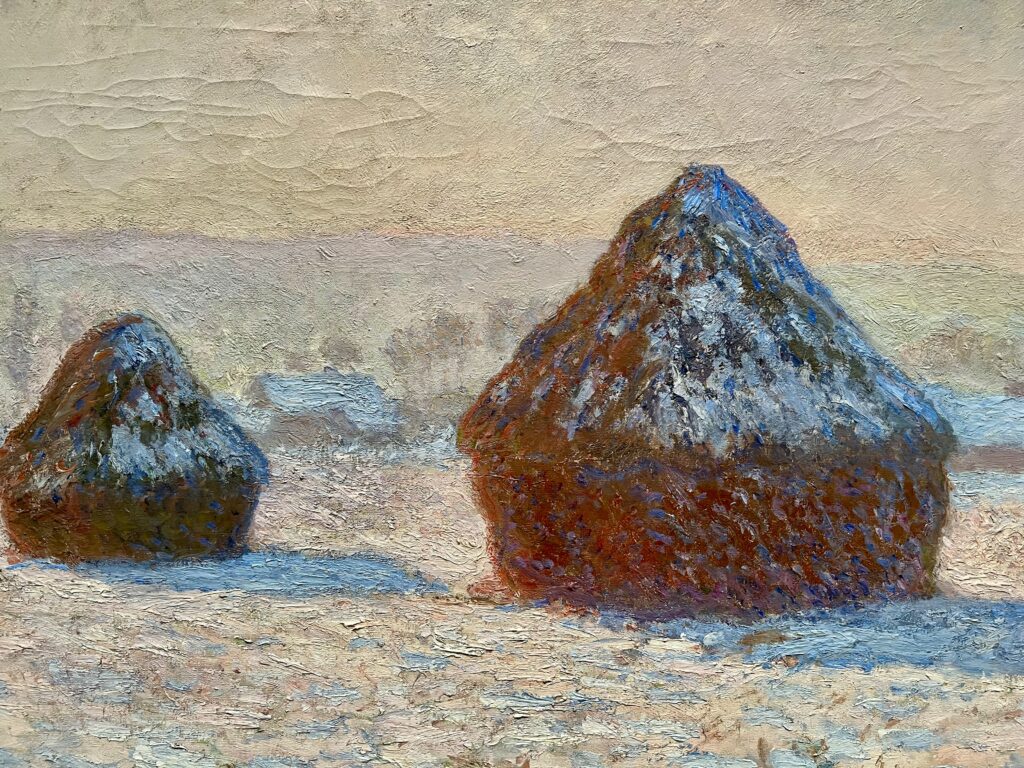
Rouen Cathedral was Monet’s third series, after the poplars and haystacks. Monet loved to paint the lacy western facade of Rouen cathedral in Normandy.
Monet painted 30 versions of Rouen Cathedral in Normandy in 1892-93. The Getty’s version was painted with morning light.
The cathedral series was a watershed moment in Monet’s career. The paintings were well-received by critics and found a ready commercial market.
READ: The Impressionism Trail In Normandy
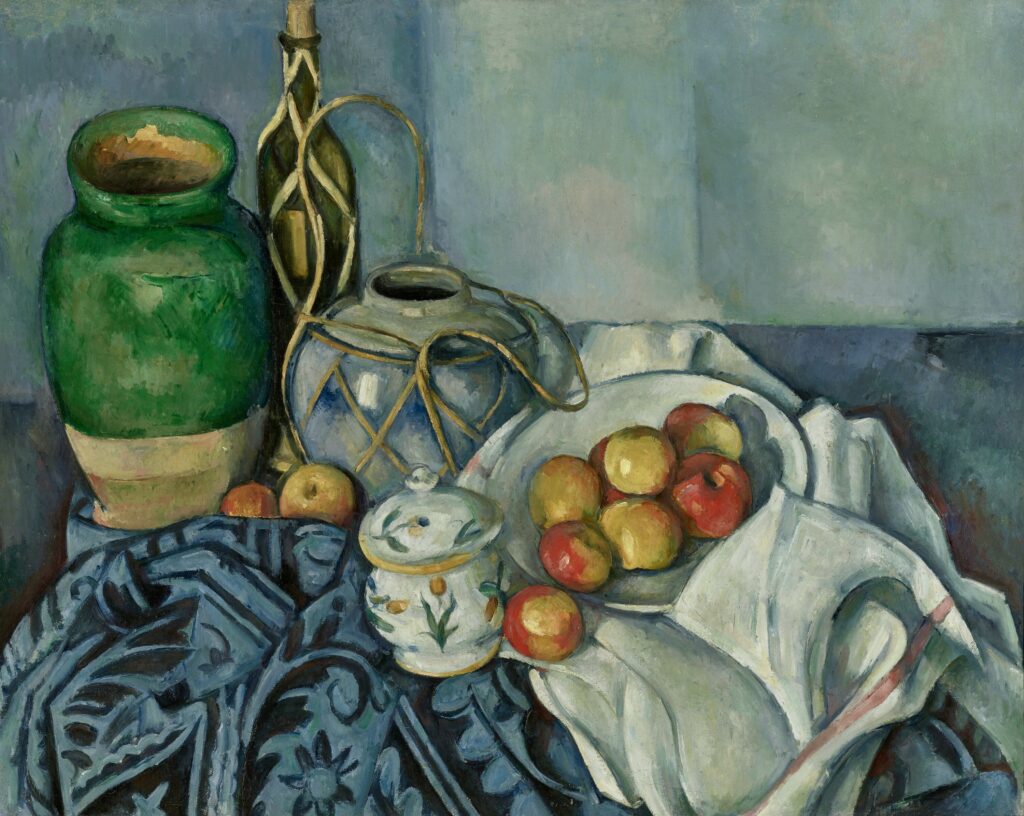
4. Cezanne, Still Life With Apples
Cezanne was a hugely influential painter of the late 19th century. Monet called Cezanne “the greatest of us all.” For Picasso, he was the father of modern art.
Cezanne threw away the long prevailing convention of single point perspective. He used multiple perspectives in a single canvas, portraying objects as sets of abstract shapes.
Still lifes were an obsessive motif for Cezanne. During the last 30 years of his life, he painted the objects in this painting –the green vase, the rum bottle, the ginger pot, and the apples — over and over again. His interest was not in the objects themselves, but in using them to experiment with shape, color, and lighting.
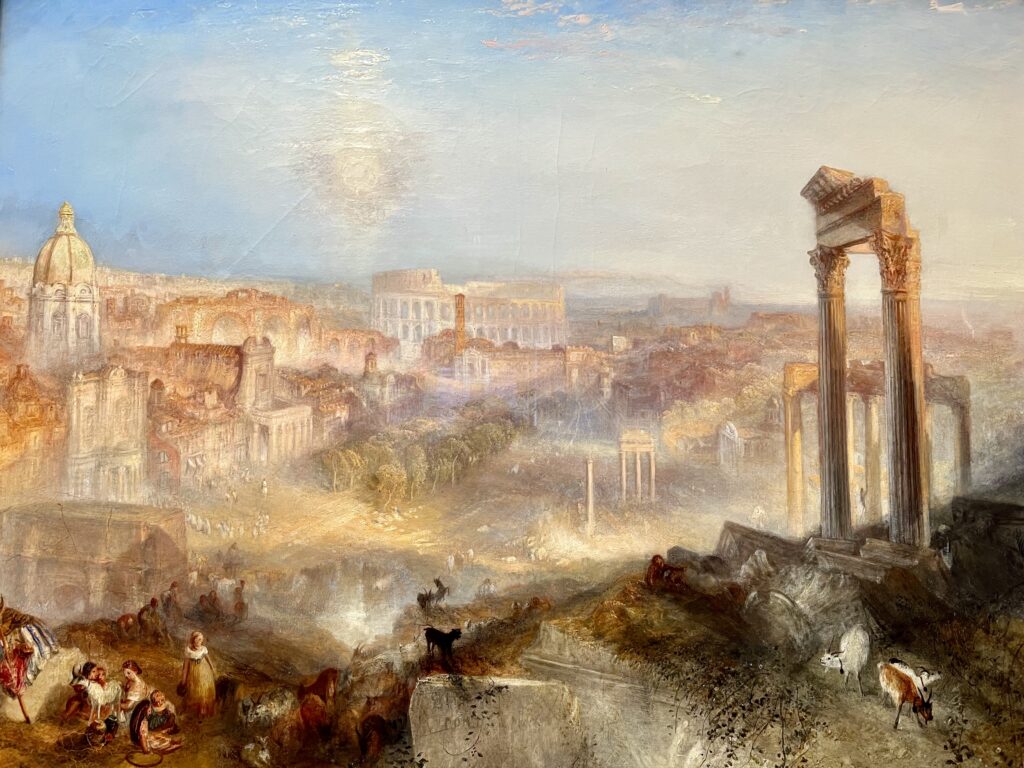
5. J.M.W. Turner, Modern Rome
Turner is Britain’s most famous and important Romantic era artist. In the mid 19th century, Turner shocked his colleagues with his loose brush strokes and fiery palette, presaging the later Impressionist movement.
In this Getty painting, Turner captures the Eternal City of Rome. The city’s ancient ruins are seen through a shimmering veil of paint and light. Amid these monuments, you see citizens carrying on with their day’s work.
The Getty acquired the painting in 2010 at a Sotheby’s auction in London for $44.9 million. Because the painting has always been behind glass, it’s in pristine condition, unusual for a Turner painting.
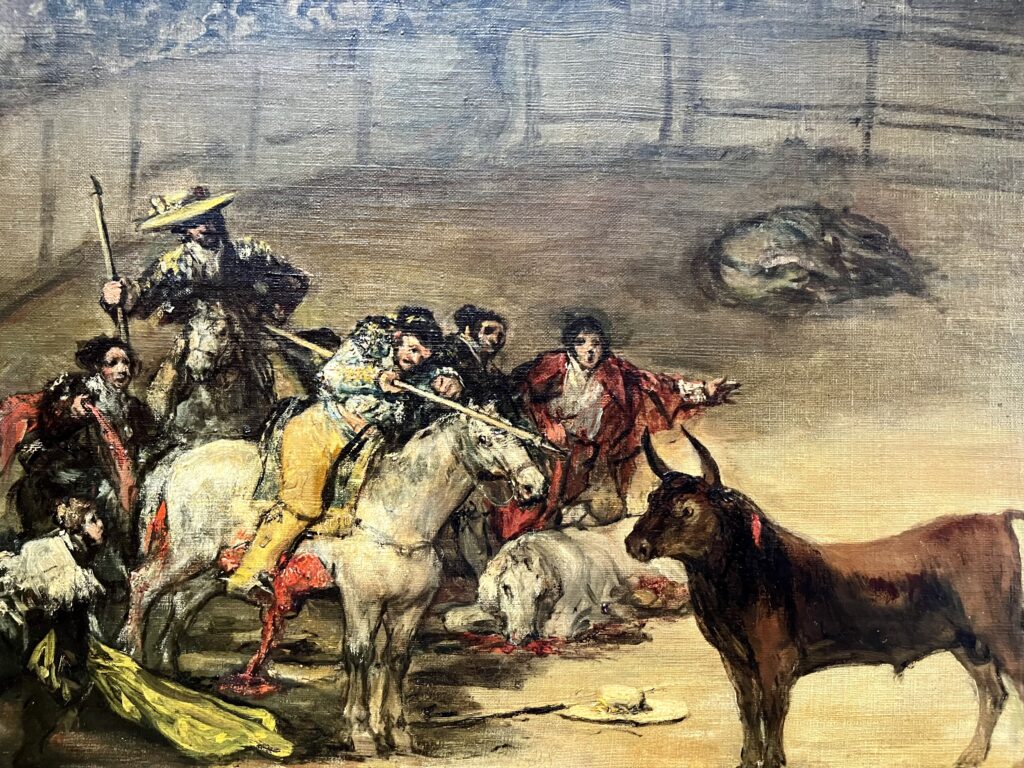
6. Goya, Bullfight
In the 19th century, Goya was the most famous painter in Spain, with no rival during his lifetime. He was the official court painter for Charles IV and Ferdinand VII, specializing in portraits and religious paintings.
Goya was known for capturing not only his subjects’ likenesses, but their personal expressiveness and individuality.
Bullfights were a lifelong theme for Goya. In this Getty painting, he depicts the fraught confrontation between a passionate picador, his terrified horse, and the besieged bull.
Goya painted this romantic scene at the end of his career. He had begun experimenting with different techniques and more ominous themes, as seen in the terrifying Black Paintings in the Prado Museum.
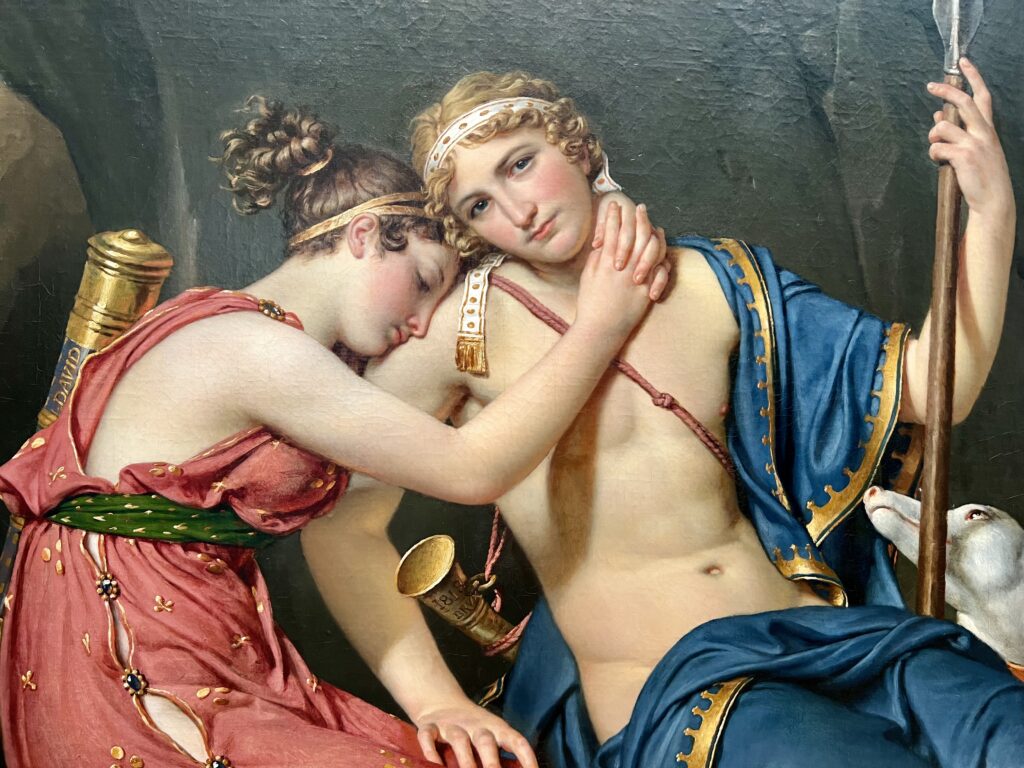
7. Jacques-Louis David, The Farewell of Telemachus and Eucharist
French artist Jacques-Louis David was a master of the grand Neo-Classical style of painting. It was a style and subject matter derived from antiquity. His painting are characterized by firm linear contours, pure colors, polished forms, and frieze-like compositions.
This painting is the very image of ideal love. It was inspired by characters from Homer’s Odyssey.
The son of Odysseus, Telemachus, falls in love with the nymph Eucharist. But he’s forced to end the romance to go off in search of his missing father. The painting conveys their sorrow.
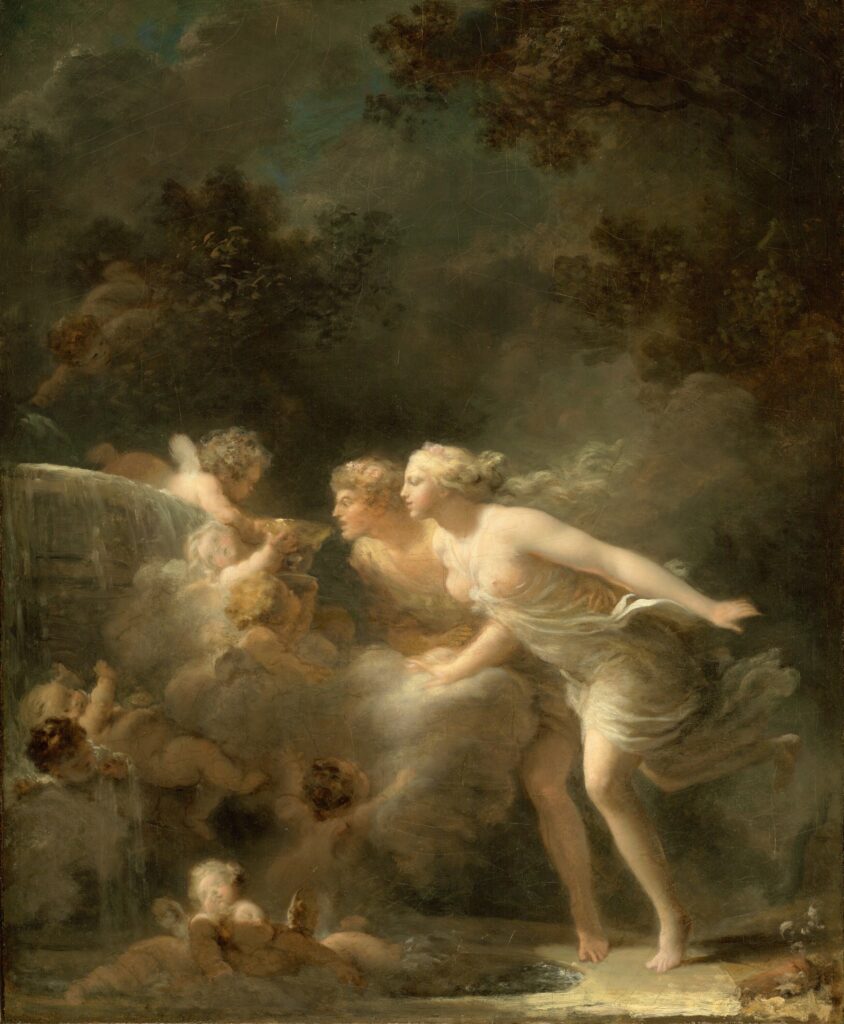
8. Jean-Honore Fragonard, The Fountain of Love
Fragonard was an 18th century French painter whose reputation rests on his light-hearted Rococo love scenes. He was renowned for his use of light, color and expressive brushstrokes.
Fragonard’s most famous painting is the iconic Swing in London’s Wallace Collection.
Like that one, this Getty Center painting, Fountain of Love, is set in a verdant and shadowy forest. Two young lovers rush to an ancient fountain to sip its magical waters. One sip and they will fall in love. It’s a dreamy and luminous moonlit image.
The Getty acquired the painting in 1999. X-ray analysis suggests that it was Fragonard’s primary version of the subject, and that a better known and more highly finished painting, The Fountain of Love in the Wallace Collection, London, was painted afterward.
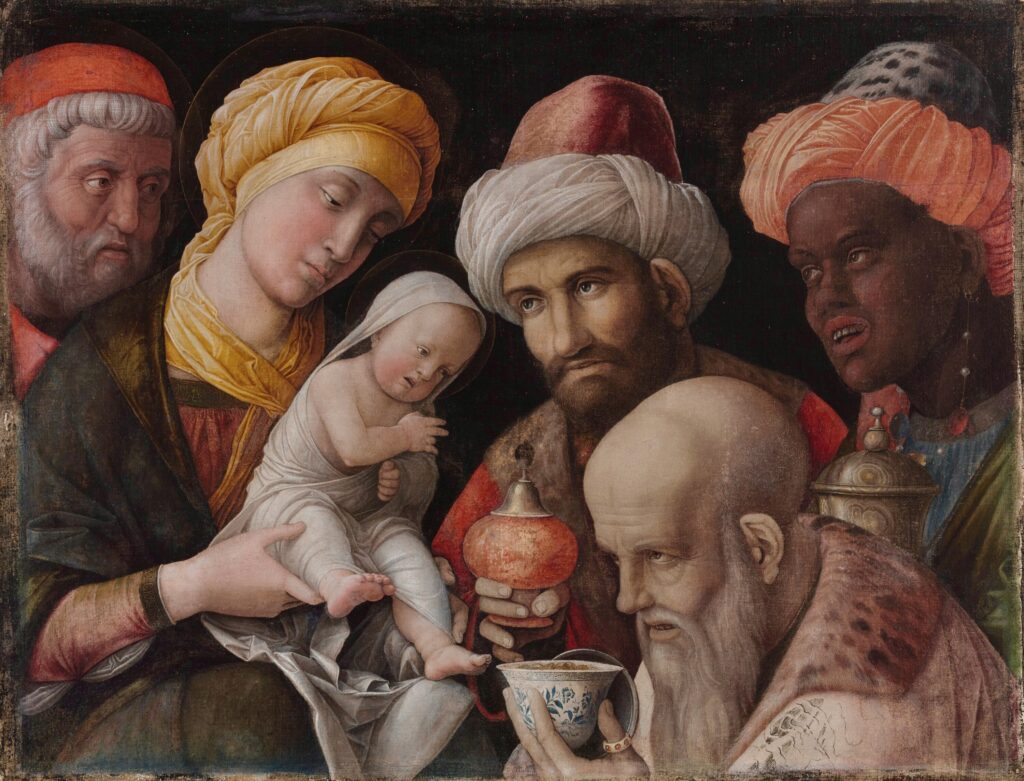
9. Andrea Mantegna, The Adoration of the Magi
Italian artist Andrea Mantegna bridged the Early and High Renaissance periods of art history. He was a pioneer of spatial illusionism.
Mantegna used visual distortions to create uncanny effects of 2D and 3D images on flat surfaces. His works reflect a perfectionist love of detail.
This painting is a close up composition of half length figures set against a neutral background. It was inspired by ancient Roman reliefs. This private devotional piece was likely created for Mantegna’s patron, the Gonzaga family of Mantua.
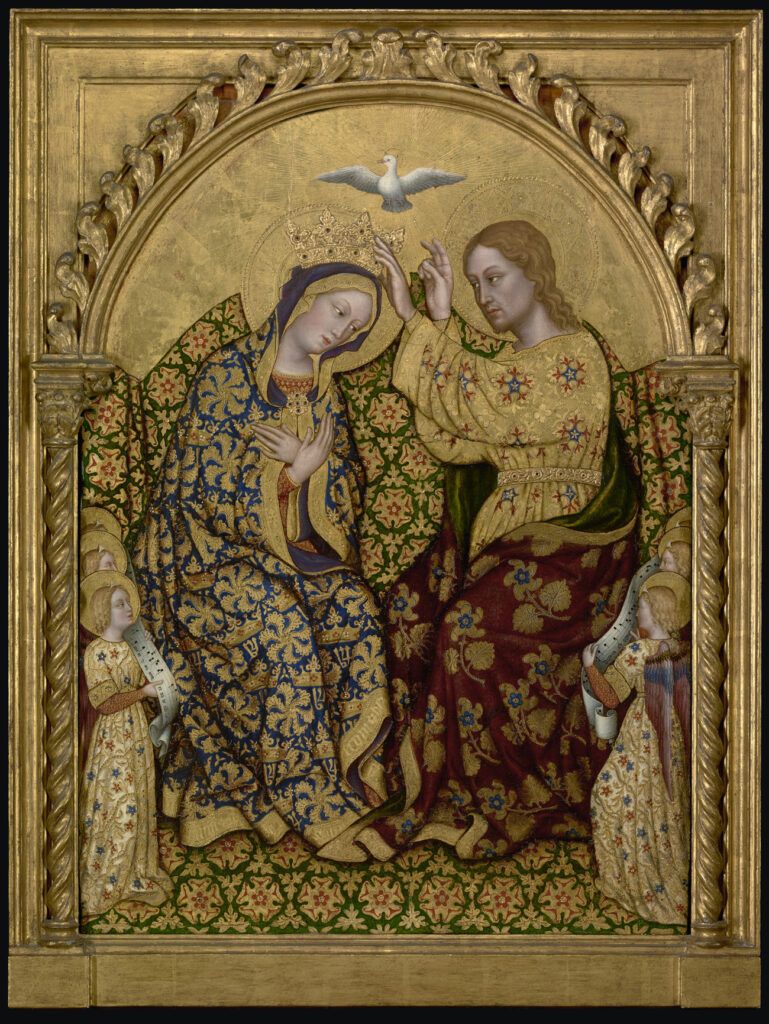
10. Gentle de Fabriano, The Coronation of the Virgin
This beautiful painting is an early Renaissance work by Italian artist Gentile da Fabriano. In a formal ceremony, Christ crowns his mother, the Virgin Mary.
The painting was once a processional standard.Typical of Fabriano’s worth painting has richly saturated colors ad decorative gold leaf.
The other side of our panel once bore another painting, also by Gentile: St. Francis Receiving the Stigmata. No one knows why the two pieces were separated.
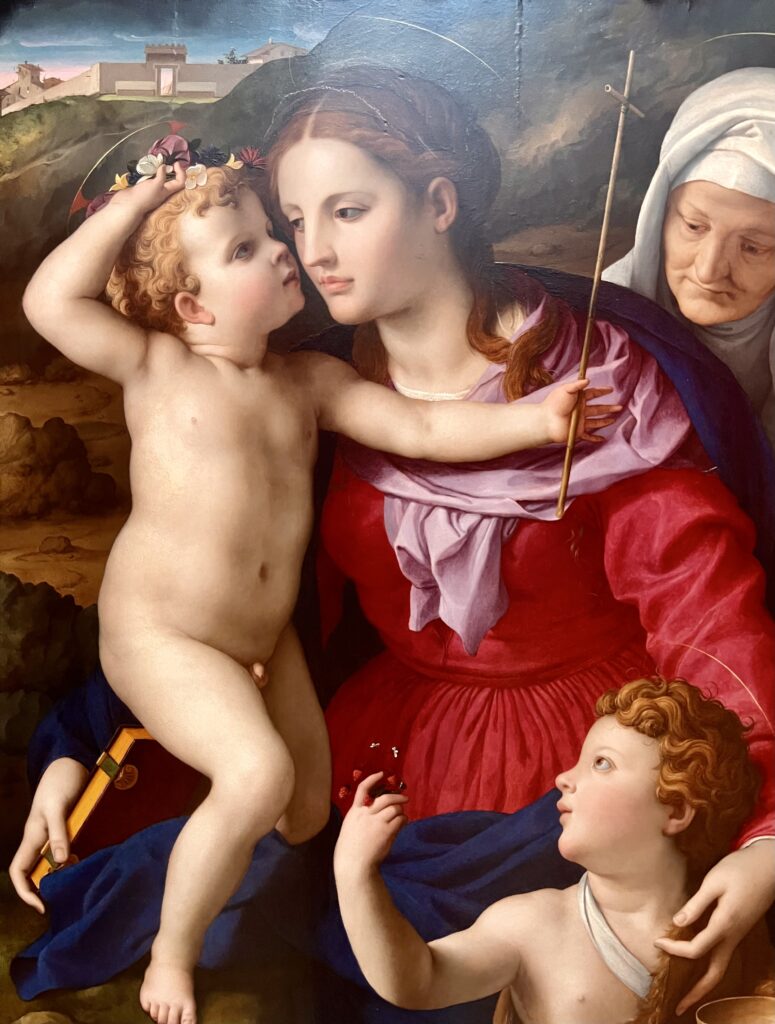
11. Bronzino, Virgin and Child
Bronzino was a Mannerist (late Renaissance) painter in the Medici Court in Florence. He’s know as an elegant master of portraiture.
This is an arrestingly beautiful and deeply saturated composition of this common grouping. The gleaming figures are crisply outlined with luminous skin. They almost appear as marble statues.
The painting was only rediscovered. It went on view at the Getty in 2019 for the first time.
The painting shows Bronzino at the height of his career. Characteristic of his style are the enamel-like surface and the lavish use of expensive pigments.
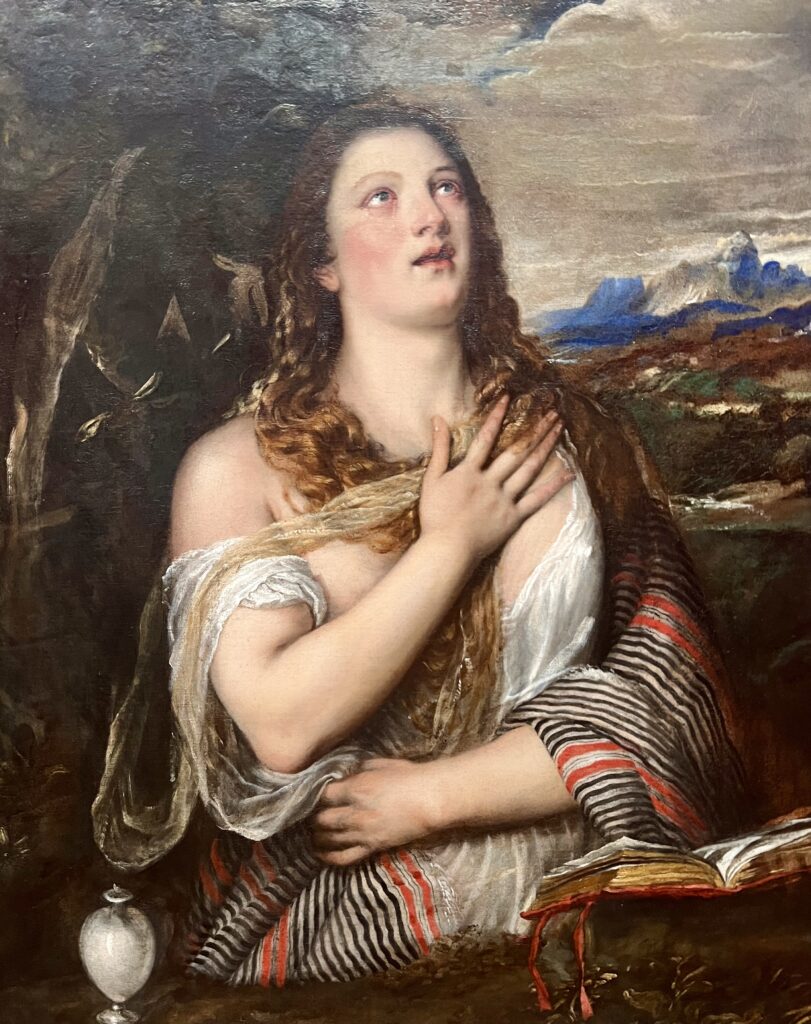
12. Titian, Penitent Magdalene
The Italian artist Titian was to Venice what Michelangelo was to Florence — a hugely important and defining artist. More than other Renaissance artist, the Venetians celebrated the sensual in art and often used courtesans as models.
Titian painted six versions of the Mary Magdalene, a famous penitent sinner. She’s a woman with a dissolute past who asks Jesus for forgiveness.
Titian portrays Mary with long, almost sensuous, copper brown hair. She tries to cover her breasts with it. She gazes upward at heaven, with a look of love and awe in her eyes.
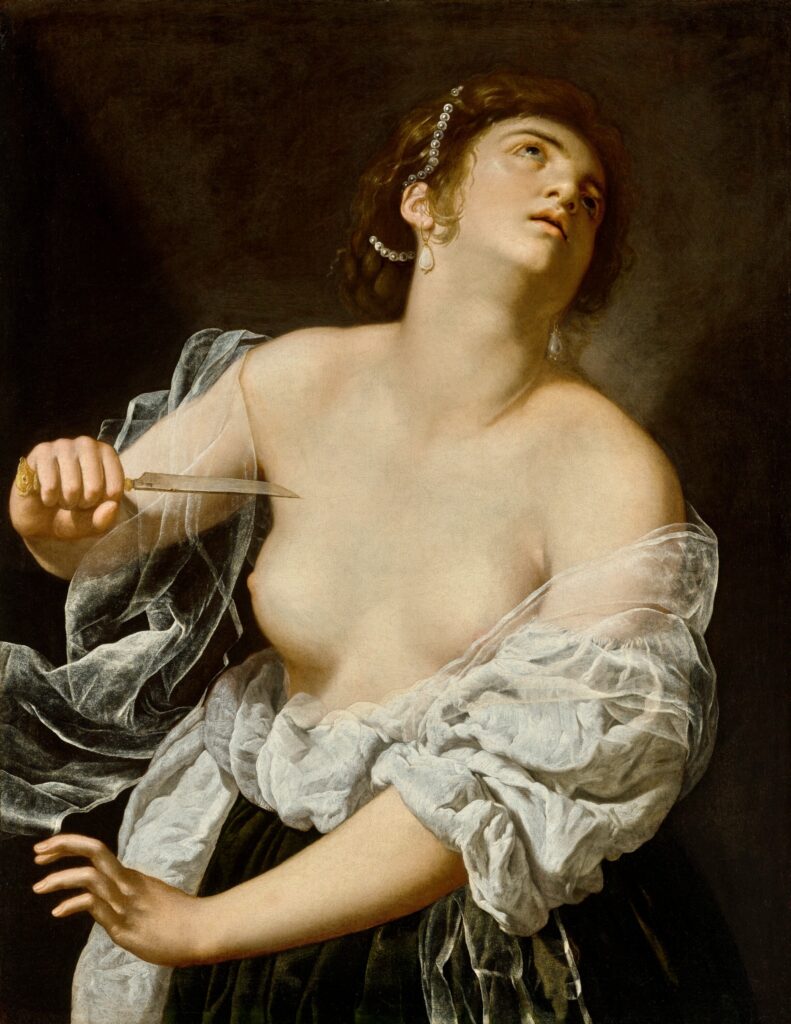
13. Artemisia Gentileschi, Lucretia
The Getty owns a rare and striking painting by the Baroque master Artemisia Gentileschi, Lucretia. It’s flanked by paintings by her artist-father Orazio Gentileschi.
In Lucretia, Gentileschi depicts a female figure on the brink of suicide. Lucretia was a Roman noblewoman. After being raped by the son of an Etruscan king, she killed herself rather than be dishonored as unchaste.
Many other painters have tackled Lucretia’s story. But none in the same way as Artemisia.
Artemisia shows the moment before the suicide, when Lucretia aims a dagger at her chest. She portrays a determined Lucretia, secure in her decision to end her life.
In the Baroque style, Lucretia’s skin and pearls are translucent and contrast with the horror of suicide.
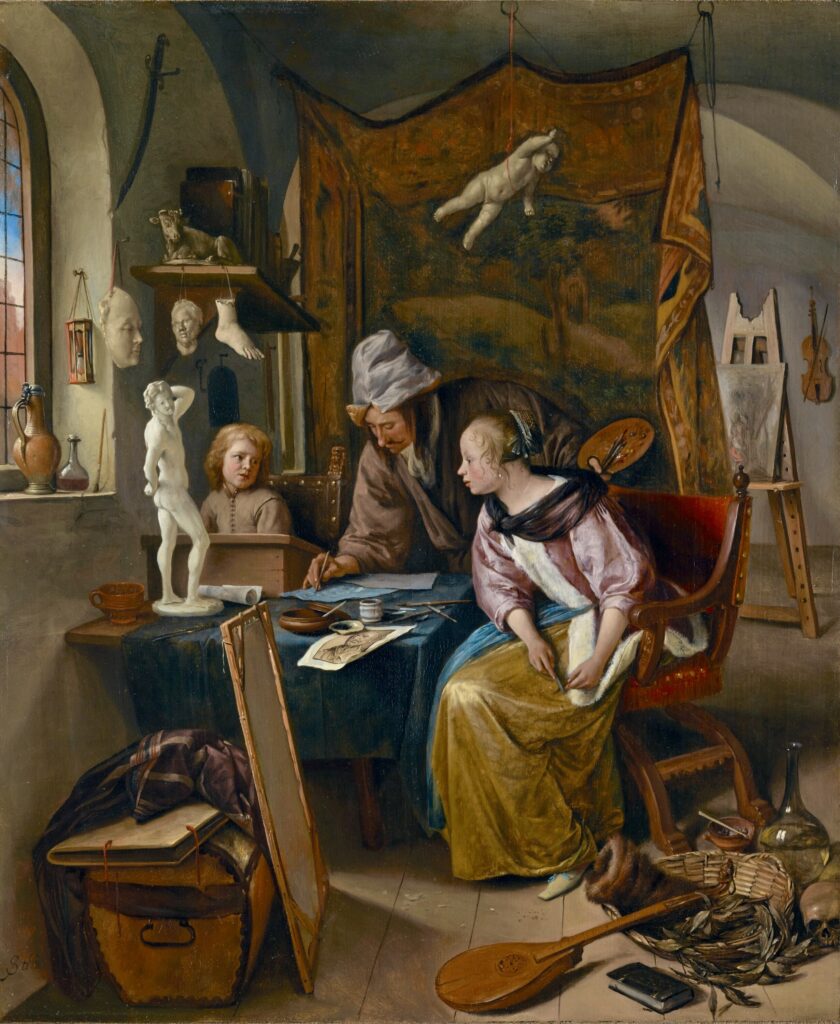
14. Jan Steen, The Drawing Lesson
Jan Steen was the humorist among Dutch Golden Age painters. He created nearly 800 paintings, most with a moral beneath the wit. In fact, moral ambiguity was a central concern of many 17th century Dutch artists.
But in The Drawing Lesson, Steen celebrates the status of the artist’s profession, a rare subject of the time. In it, a painter tutors a young boy and girl who are tasked with drawing a plaster cast of a male nude.
The studio is littered with objects that were the frequent subject of Dutch still lifes. Steen’s technique is especially refined.
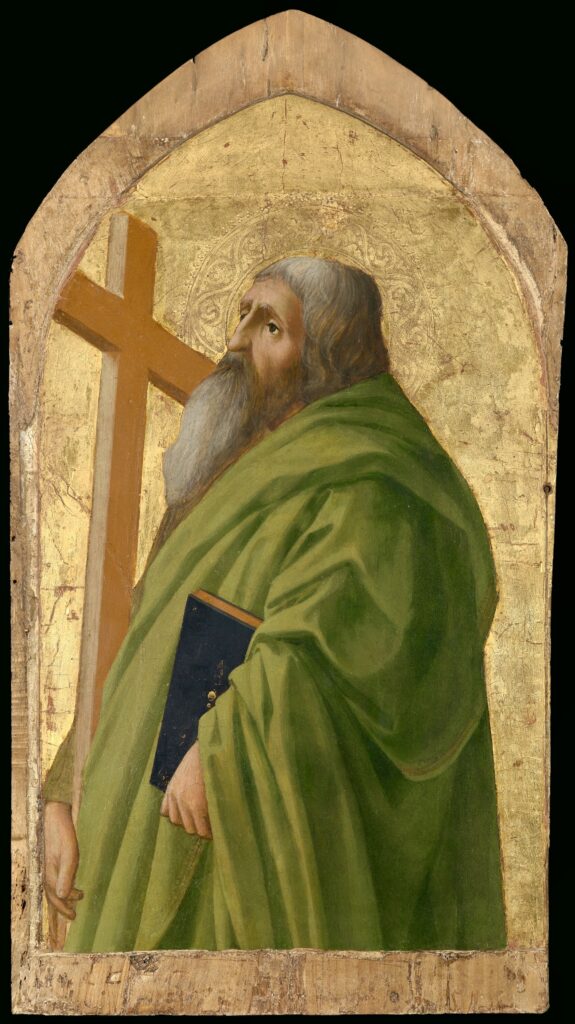
15. Masaccio, Saint Andrew
The artist Masaccio was a Renaissance wunderkind. Though his life went by in a flash (he died at 27), he was a hugely innovative painter. He was the first painter in art history to experiment with linear point perspective.
His radical ideas about what could be done on a flat surface helped shape the history of Western art. Some art historians call Masaccio the first truly Renaissance artist.
The Getty owns Masaccio’s painting of Saint Andrew. It’s a panel that was formerly in a private chapel in Pisa Italy.
The saint is shown with his usual attributes, a cross and a book. His features are careworn. His haunted gaze is one of the first steps toward the naturalism that would dominate Italian Renaissance art.
READ: Guide To Masaccio’s Brancacci Chapel In Florence
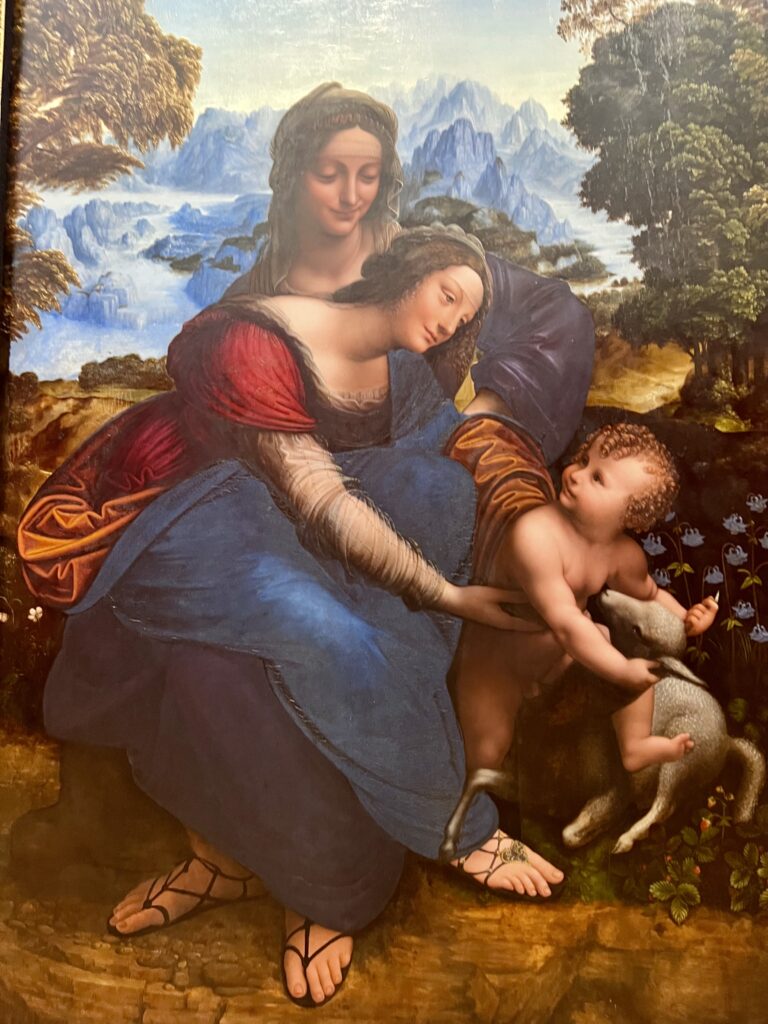
16. Workshop of Leonardo, Madonna and Child with Saint Anne
If you can’t get to the Louvre to see Leonardo da Vinci’s The Virgin and Child With Saint Anne, you can see a faithful copy of it at the Getty Center. It was created by Leonardo’s worship in Milan, possibly by his lover and pupil Salai.
In the painting, the infant Chris turns toward his mother as he mischievously tugs the ears of a lamb. It has the classic background landscape invented by Leonardo — a misty vista of mountains.
READ: Guide To the Paintings of Leonardo da Vinci
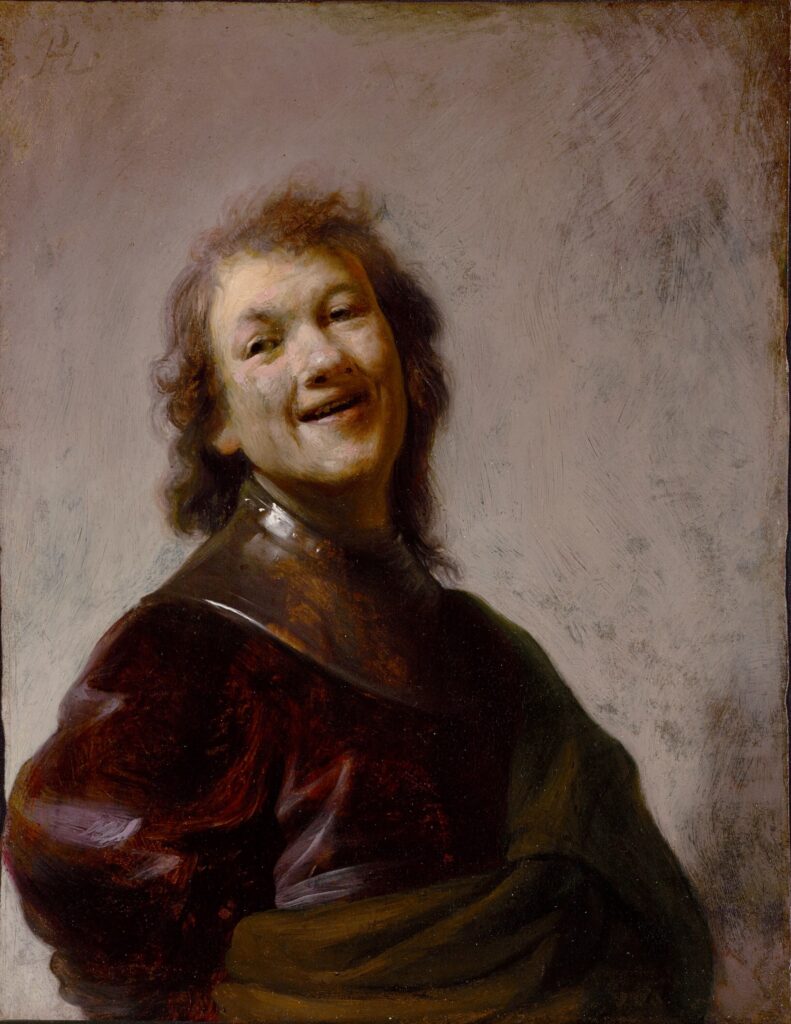
17. Rembrant, Rembrandt Laughing
Rembrandt is considered the greatest painter of the Dutch Golden Age.He was renowned for his ability both to depict very realistic human figures and portray deep human emotion.
His extensive self-portraits (over 80) form a unique visual biography of the artist. He always portrayed himself without vanity and with a vulnerable sincerity.
In 2012, the Getty acquired one of Rembrandt’s self portraits, Rembrandt Laughing. It’s an early self-portrait, depicting the 22 year old artist as a soldier. His features are animated as if captured in a spontaneous moment.
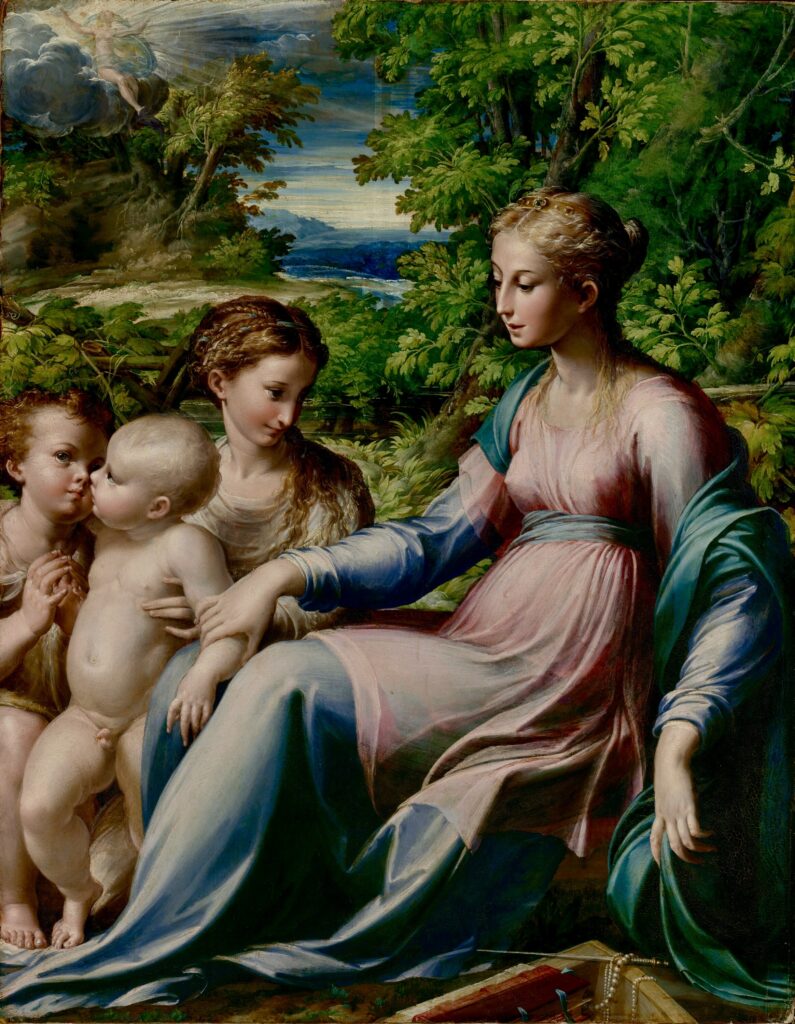
18. Parmigianino, Virgin and Child With Saint John the Baptist and Mary Magdalene, 1535-40
With the possible exception of his nemesis Correggio, Parmigianino was the leading painter of Palma Italy. He was technically adept virtuoso who also worked in Rome and Bologna.
Like Bronzino, he was brilliant exponent of the Mannerist style. The Getty painting has a polished and enamel-like surface, with a lush landscape.
The original function of this painting is unknown, but its scale and subject matter imply that it was perhaps independently commissioned for a private chapel. The unconventional iconography of this painting typifies Parmigianino’s innovative work.
READ: Best Renaissance Paintings in the United States
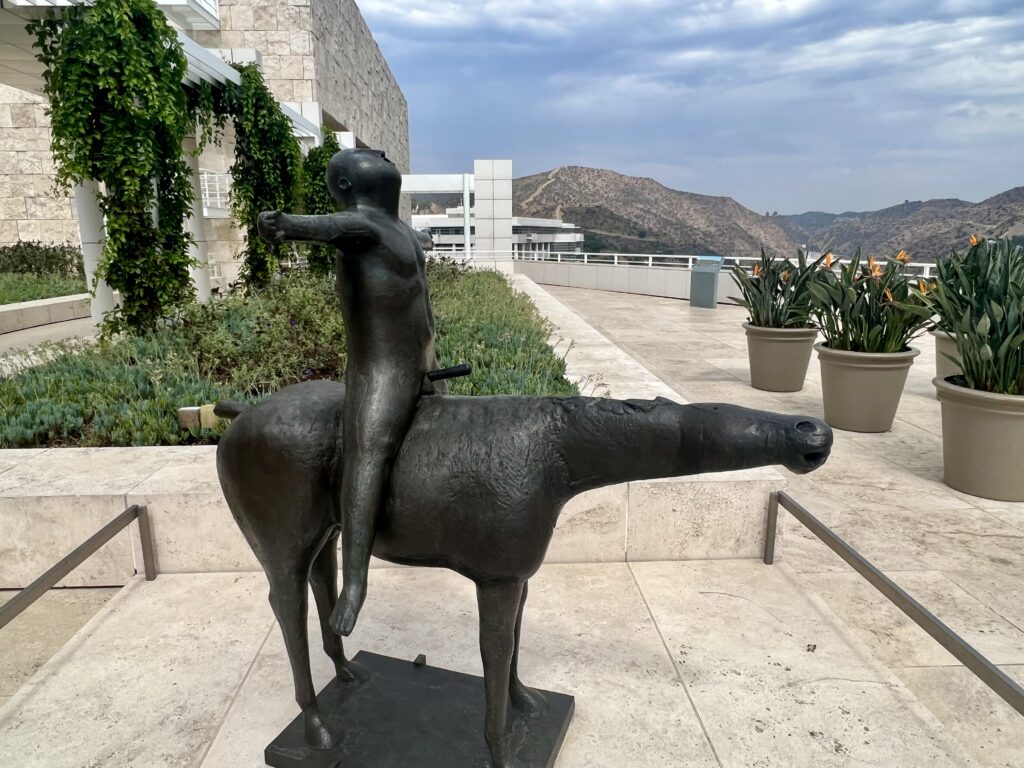
19. Modern Outdoor Sculpture
The Getty Center has an impressive collection of outdoor sculpture, consisting mostly of works bequeathed by the late legendary film producer Ray Stark and his wife, Fran.
Most of the sculptures can be found in The Fran and Ray Stark Sculpture Garden (near the tram) and The Fran and Ray Stark Sculpture Terrace (adjacent to the Museum’s West Pavilion).
I’ll just highlight a few pieces.
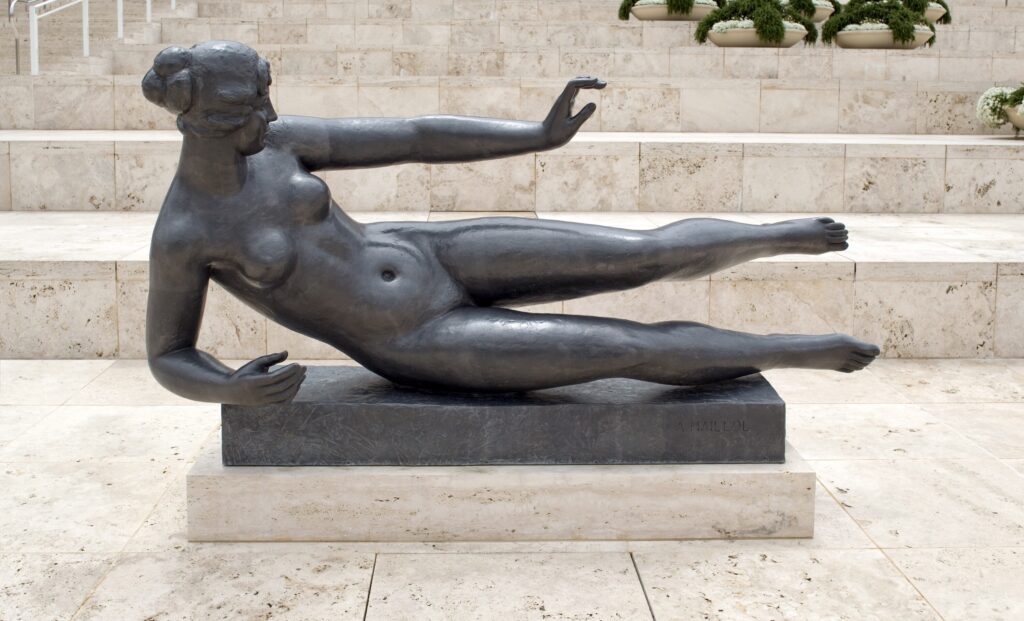
Aristide Maillol’s Air is located on the Museum’s grand staircase, You’ll see it as you enter the complex.
Maillol was a French sculptor who specialized in monumental sculptures of nude women. His sculptures were both objects and allegorical.
With a grayish-blue surface, Air seems to float in space. She’s idealized, a personification of air. You’ll also find his Torso of Dina and Torso of Summer on the museum grounds.
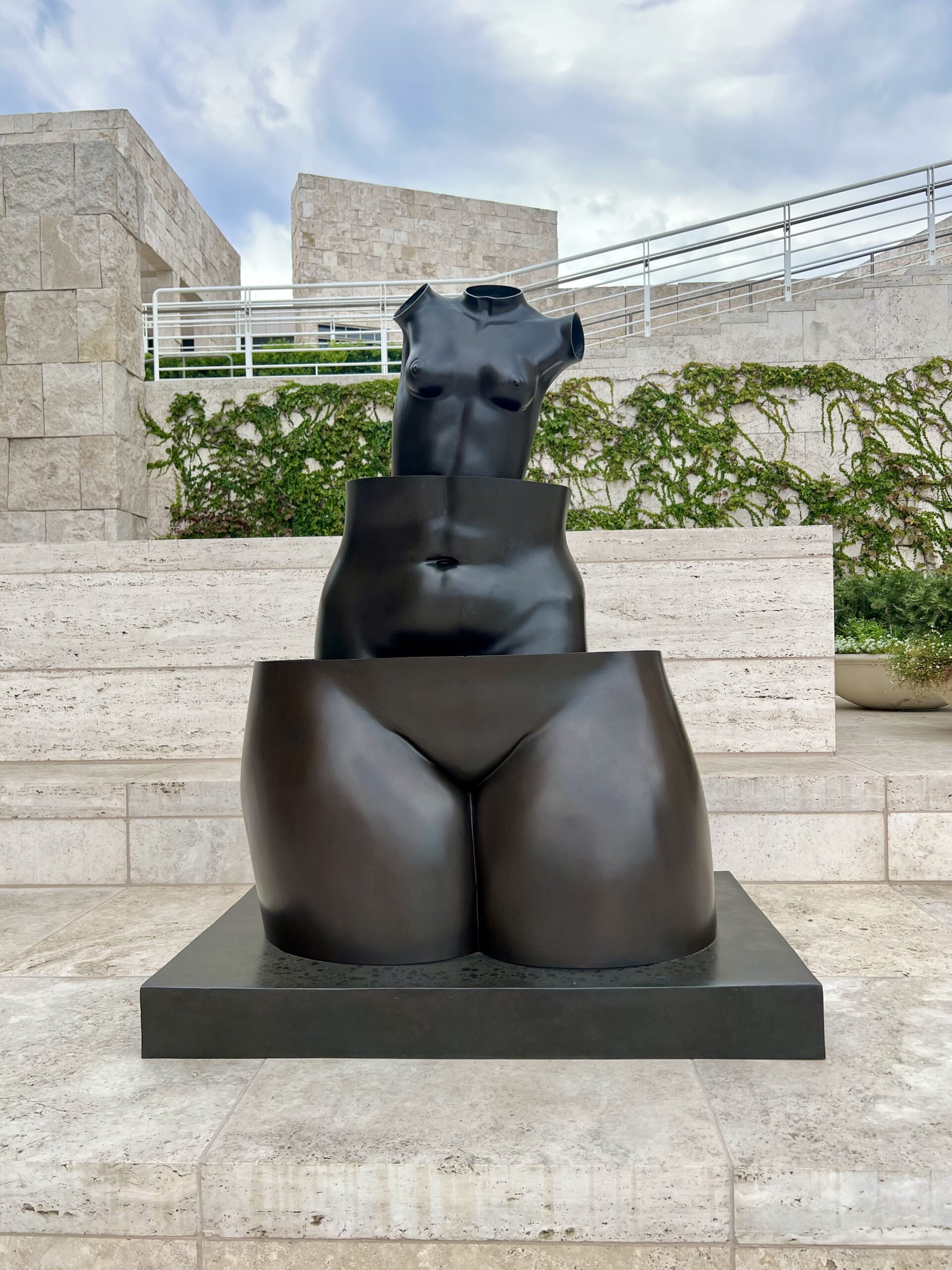
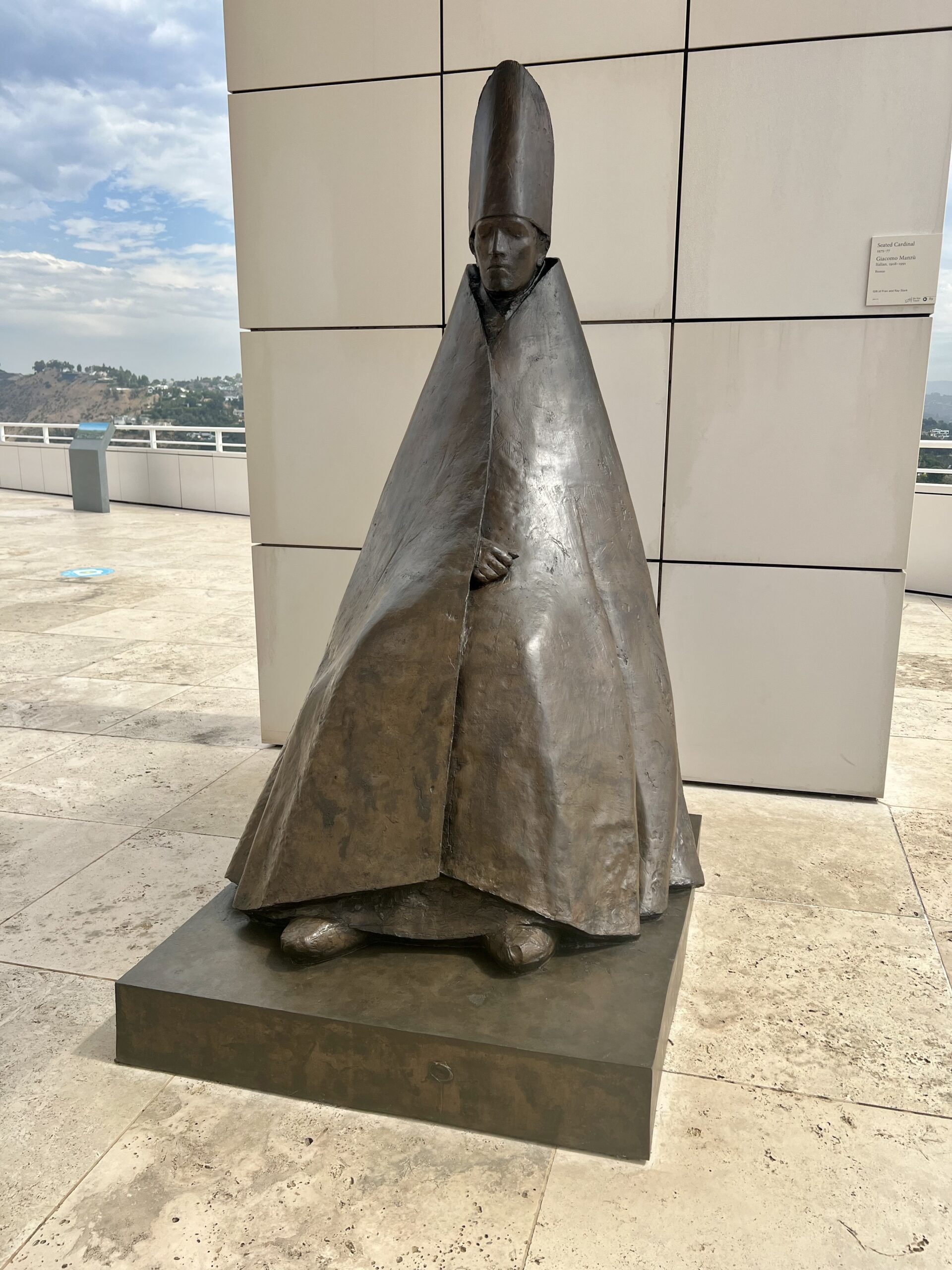
Marino Marini is known for his equestrian sculptures. Angel of the Citadel depicts a man astride his horse, excited by the pure joy of living. Every part of his body is alert and stretched, even, intentionally, his manhood.
Seated Cardinal is a work by Italian artist Giacomo Manzu on the south terrace. Manzu created sculptures that were not simply representational, but were also symbols of universal meaning. This simplified form was inspired by the stiff looking cardinals he encountered at St. Peter’s Basilica in Vatican City.
The Getty also owns some bronze sculptures by British artist Henry Moore. He was a radical and experimental artist who became the leading sculptor of his generation and a pioneer of modern sculpture.
You can see his intentionally distorted Seated Woman, Draped Reclining Mother and Baby, and his Bronze Form (more than 14 feet high!). The reclining pose was one of Moore’s favorite, as was the mother and child theme.
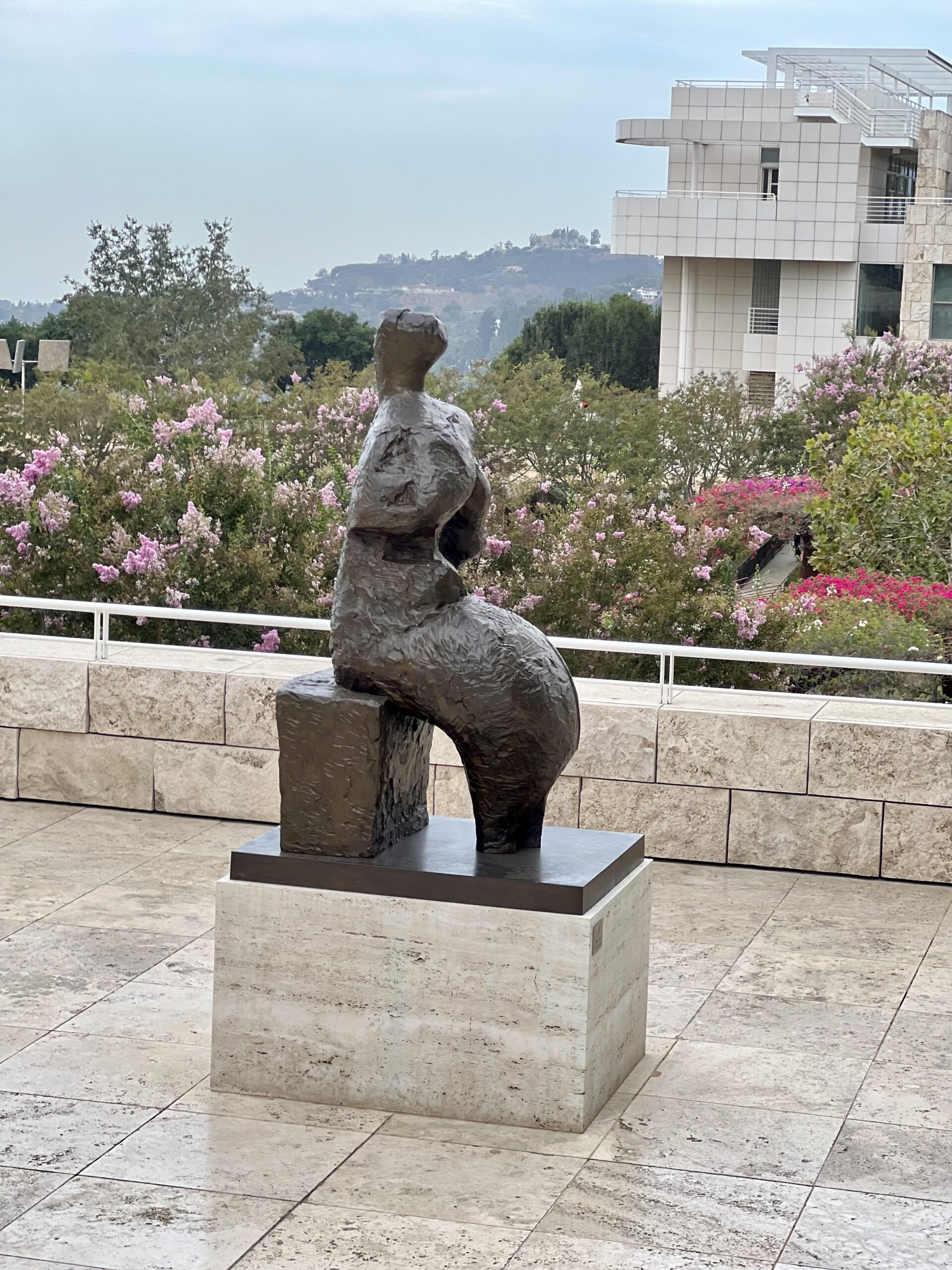
A couple other modern sculptures to looks for are Roy Lichtenstein’s Three Brushstrokes, Alberto Giacometti’s Standing Woman I, and Rene Magritte’s Delusion of Grandeur.
20. Getty Gardens
From its inception, outdoor gardens were pivotal to the Getty’s mission of building a beautiful space to experience art.
Architects wanted the landscape and architecture to interact and reflect the changing seasons, with brilliant pink and red blooms contrasting with the pale travertine. 32 full time gardeners work at the Getty to achieve this sublime effect.
The most beloved space is the Central Garden. Designed by Robert Irwin, you access the garden by a zig zagging path, a stream coursing underneath. The garden culminates in a reflecting pool in which a maze of colorful azaleas seem to float.
Five water gardens also enliven the space at the Getty. The Museum Courtyard has a long reflecting pool with jets and a secluded pool with rocks and a fountain.

Practical Guide & Tips For Visiting The Getty Center
Address:
1200 Getty Center Drive, Los Angeles, CA 90049
Hours:
The Getty Center is open Tuesday through Friday and Sunday from 10:00 am to 5:30 pm. Saturday hours are 10:00 am to 8:00 pm. Closed Mondays.
Tickets:
The Getty Center is completely free, which is amazing for a museum of this caliber. To visit, you just have to book a timed entry ticket online (no fee). You’ll be turned away without a reservation.
Print your ticket out to show the attendants. But they can also look up your ticket by name, if you’re traveling and don’t have access to a printer.
If you’re visiting in the high season (summer), you should book several weeks in advance. Otherwise, it’s probably fine to book several days or a week in advance.
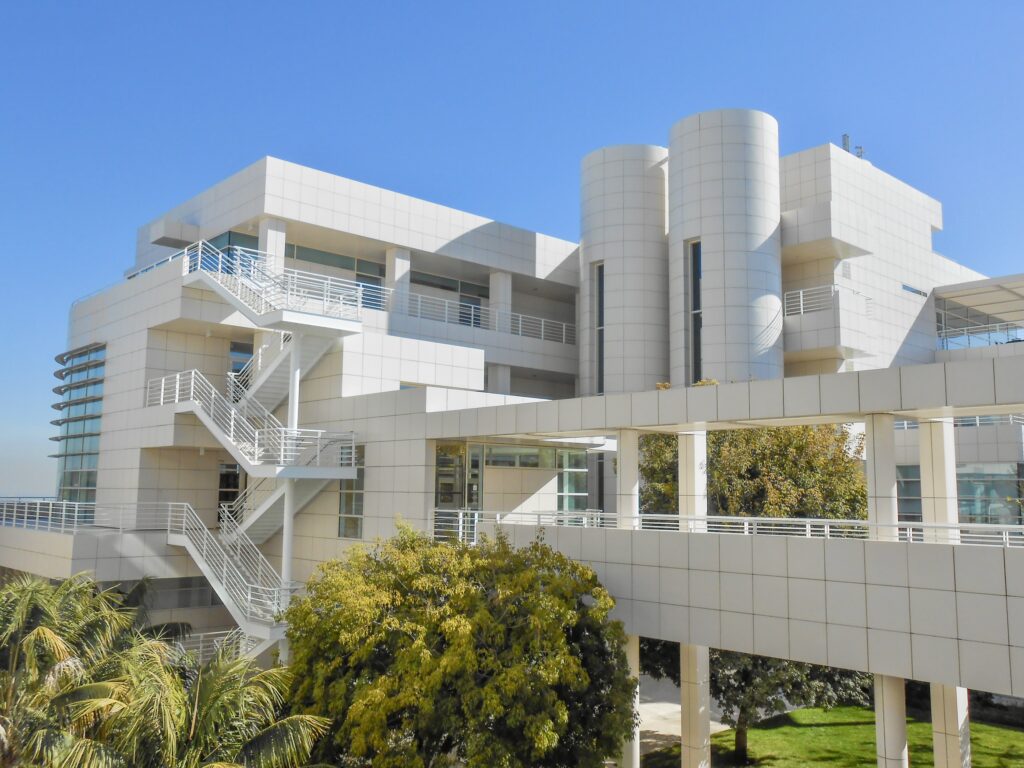
Tours:
The Getty offers many free tour. They leave from the Information Desk and include:
- Architecture Tour: 45 minute outdoor tour at 11:00 am, 12:00 pm, 1:00 pm, and 2:00 pm
- Garden Tour: 45 minute outdoor tour focusing on the Central Garden at 11:00 am, 12:00 pm, 1:00 pm, and 2:00 pm
- Spotlight Tour: Quick 20 minute tour of the special exhibition at the Getty at 11:15 am, 12:15 pm, 1:15 pm, and 2:15 pm
- Collections Tour: 45 minute tour featuring select masterpieces at 11:30 am, 12:30 pm, 1:30 pm, and 2:30 pm
For a more extensive tour, you may want to book this 90 minute guided tour, which focuses on either the highlights or a particular period of art history.
Parking & Shuttle:
You’ll need to park in the designated parking lot, which costs $20. You get a ticket and pay at the pay station machine on your way out.
From the parking lot, you will need to check in and give your ticket to the attendant. Then, you board a tram that takes you to the Getty Center in 5 minutes or so. On the brief ride, you’ll see the unfolding vistas of the museum.
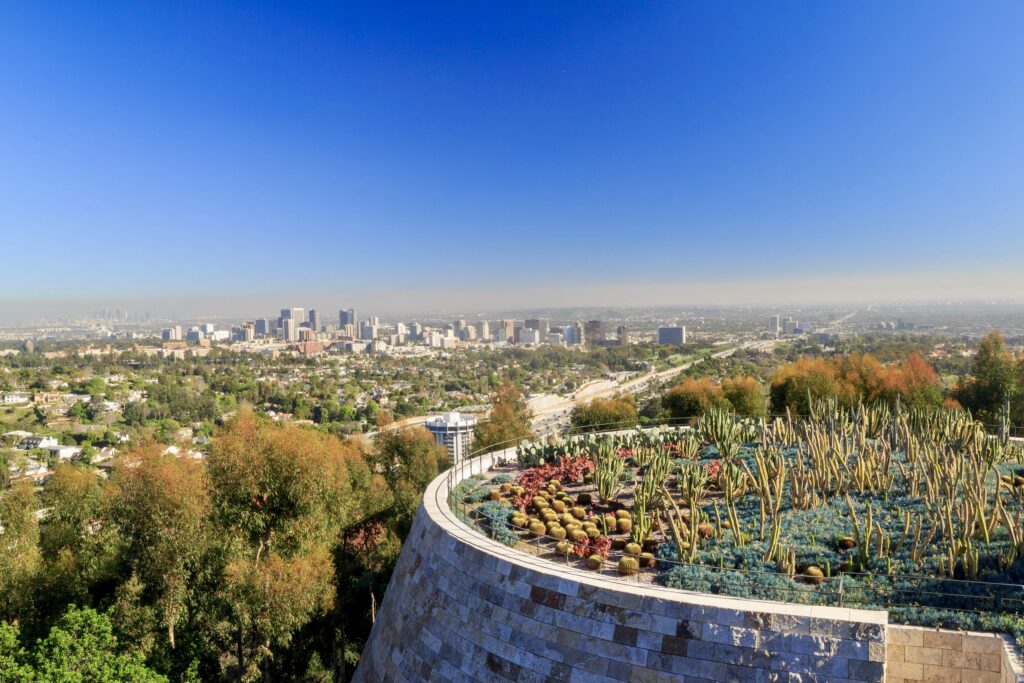
How Long To Visit The Getty Center?
I think the Getty Center deserves at least 3 hours for a first time visitor. It’s a large complex. There are many pavilions, special exhibitions, the gardens, the outdoor sculptures, etc.
If you are an art lover, you may want to dedicate the better part of the day to the Getty.
For example, you could arrive around 10:00-10:30 am, break for lunch at the Garden Terrace Cafe, and then spend a couple more hours admiring the art. You’ll need to make a reservation on Open Table for the restaurant.
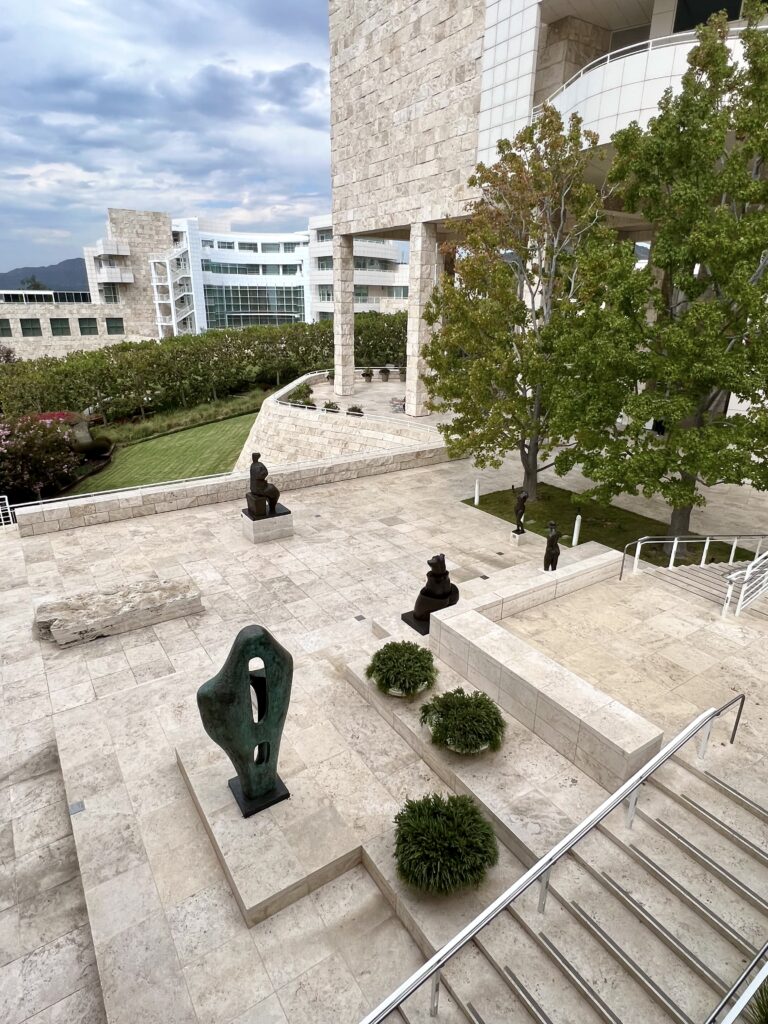
Food at the Getty Center:
There are four food options at the Getty Center.
The Restaurant on the Plaza level is a sit down space with majestic views. You’ll need to make reservations in advance on Open Table to ensure a a spot, it’s poplar. You can also book afternoon tea on Friday and Saturday from 2:00 to 3:00 pm.
There’s also the Garden Terrace Cafe overlooking the Central Arden and a self service cafe on the lower level with sandwiches, soups, etc.
There’s also a coffee art with food and beverages in the Museum Courtyard. This honestly wasn’t bad. I missed my reservation at the restaurant beccause there is just so much to see, but had a tasty chicken curry wrap instead.
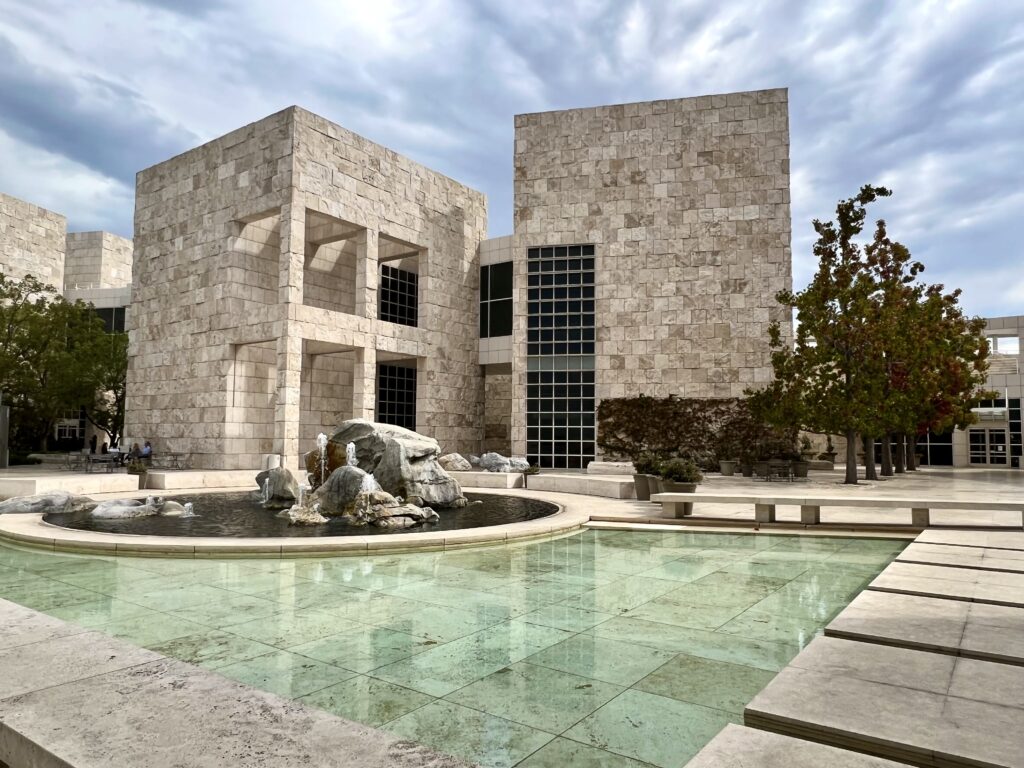
Is The Getty Center Worth Visiting?
100% yes. The Getty Center is one of the top museums in the United States and it’s magnificent.
Even if you’re not an art lover, it will delight. The buildings and gardens are beautiful and you have stunning views of LA from every terrace.
If you’re an art lover that admires Old Masters, the Getty is a must visit US bucket list destination. Plus, it has one of the most famous Van Gogh paintings in the US.
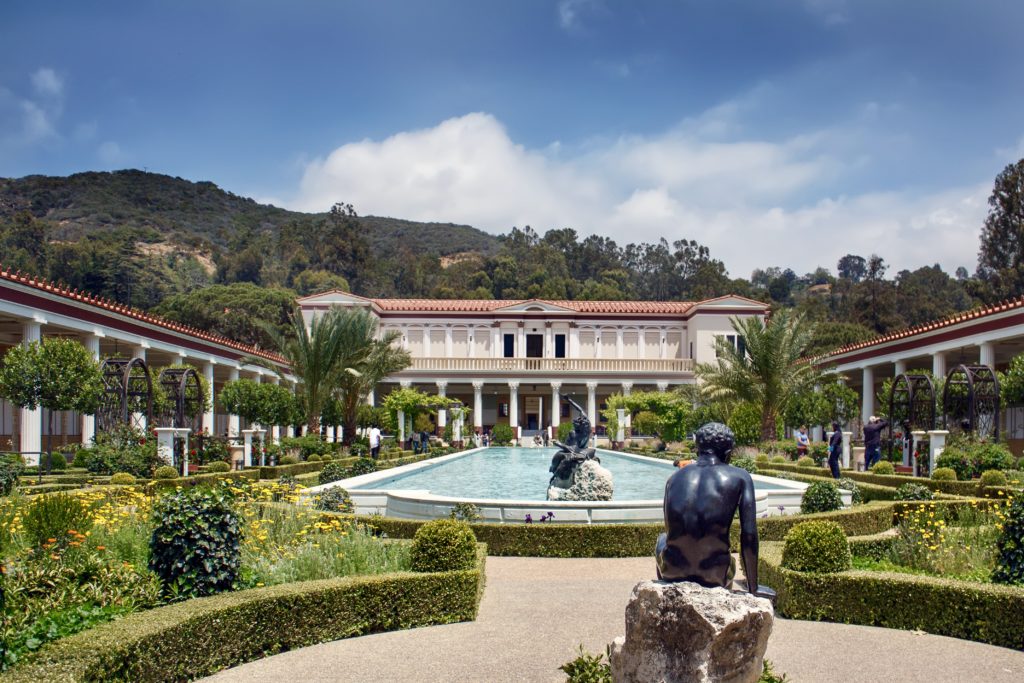
What To Visit Near The Getty Center
The best place to visit in conjunction with the Getty Center is the Getty Villa, just 15-25 minutes down the road.
The villa is a pristine recreation of a seaside Roman estate housing billionaire oilman J. Paul Getty’s collection of Greco-Roman antiquities. It’s wonderful and the perfect way to see all of the Getty’s treasures in one day!
Here’s my compete guide to the Getty Villa.
I hope you’ve enjoyed my guide to the Getty Center. You may enjoy these other US travel guides and resources:
- 1 day itinerary for Portland Maine
- 2 day itinerary for Philadelphia
- 3 day itinerary for Boston
- 1 day itinerary for Denver
- 2 day itinerary for Cleveland Ohio
- 10 day itinerary for New Hampshire
- 10 day itinerary for coastal Maine
- 7-10 day itinerary for Vermont
- One week itinerary for southern New England
- Fall foliage road trip in New England
- 25 most beautiful towns in New England
- 45 amazing destinations in the United States
If you’d like to visit the Getty Center, pin it for later.

